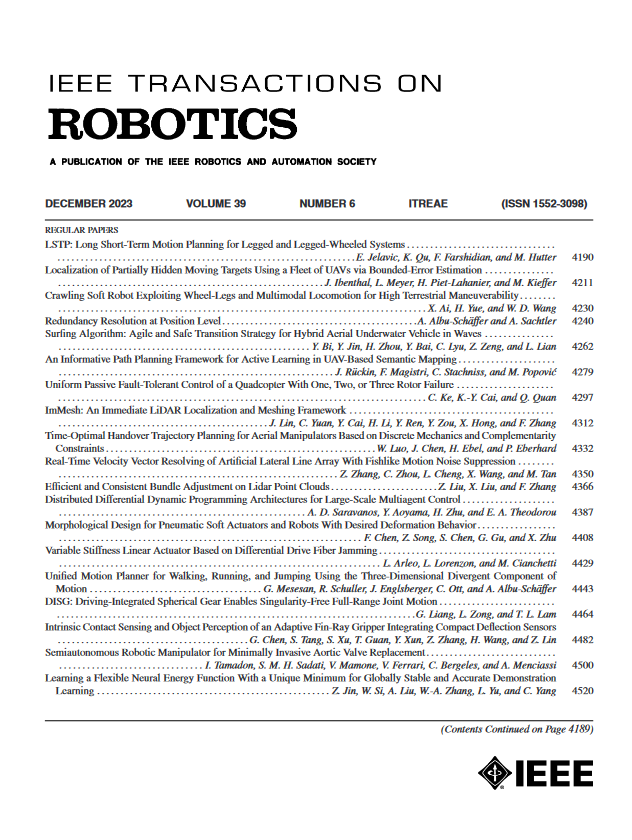自主导航的嵌入式分层MPC
IF 10.5
1区 计算机科学
Q1 ROBOTICS
引用次数: 0
摘要
为了在社会中有效地部署机器人系统,移动机器人必须在复杂的环境中自主安全地移动。非线性模型预测控制(MPC)方法提供了一种自然的方法,在不与附近障碍物碰撞的情况下,在环境中找到动态可行的轨迹。然而,典型的嵌入式机器人系统(如四旋翼飞行器)的计算能力有限,这对实时运行MPC提出了挑战,包括其最昂贵的任务:约束生成和优化。为了解决这个问题,我们提出了一种新的分层MPC方案,该方案由规划层和跟踪层组成。规划器以较慢的速度构建具有较长预测视界的轨迹,而跟踪器以较快的速度保证轨迹跟踪。我们证明了该框架避免了冲突,并且是递归可行的。此外,我们在模拟和实验室实验中证明了它的有效性,需要在复杂的静态环境中达到目标位置的四旋翼飞行器。该代码在四旋翼飞行器的嵌入式计算机上有效实现,保证了实时性的可行性。与最先进的单层MPC配方相比,这使我们能够将规划范围增加5倍,从而显著提高性能。本文章由计算机程序翻译,如有差异,请以英文原文为准。
Embedded Hierarchical MPC for Autonomous Navigation
To efficiently deploy robotic systems in society, mobile robots must move autonomously and safely through complex environments. Nonlinear model predictive control (MPC) methods provide a natural way to find a dynamically feasible trajectory through the environment without colliding with nearby obstacles. However, the limited computation power available on typical embedded robotic systems, such as quadrotors, poses a challenge to running MPC in real time, including its most expensive tasks: constraints generation and optimization. To address this problem, we propose a novel hierarchical MPC scheme that consists of a planning and a tracking layer. The planner constructs a trajectory with a long prediction horizon at a slow rate, while the tracker ensures trajectory tracking at a relatively fast rate. We prove that the proposed framework avoids collisions and is recursively feasible. Furthermore, we demonstrate its effectiveness in simulations and lab experiments with a quadrotor that needs to reach a goal position in a complex static environment. The code is efficiently implemented on the quadrotor's embedded computer to ensure real-time feasibility. Compared to a state-of-the-art single-layer MPC formulation, this allows us to increase the planning horizon by a factor of 5, which results in significantly better performance.
求助全文
通过发布文献求助,成功后即可免费获取论文全文。
去求助
来源期刊

IEEE Transactions on Robotics
工程技术-机器人学
CiteScore
14.90
自引率
5.10%
发文量
259
审稿时长
6.0 months
期刊介绍:
The IEEE Transactions on Robotics (T-RO) is dedicated to publishing fundamental papers covering all facets of robotics, drawing on interdisciplinary approaches from computer science, control systems, electrical engineering, mathematics, mechanical engineering, and beyond. From industrial applications to service and personal assistants, surgical operations to space, underwater, and remote exploration, robots and intelligent machines play pivotal roles across various domains, including entertainment, safety, search and rescue, military applications, agriculture, and intelligent vehicles.
Special emphasis is placed on intelligent machines and systems designed for unstructured environments, where a significant portion of the environment remains unknown and beyond direct sensing or control.
 求助内容:
求助内容: 应助结果提醒方式:
应助结果提醒方式:


